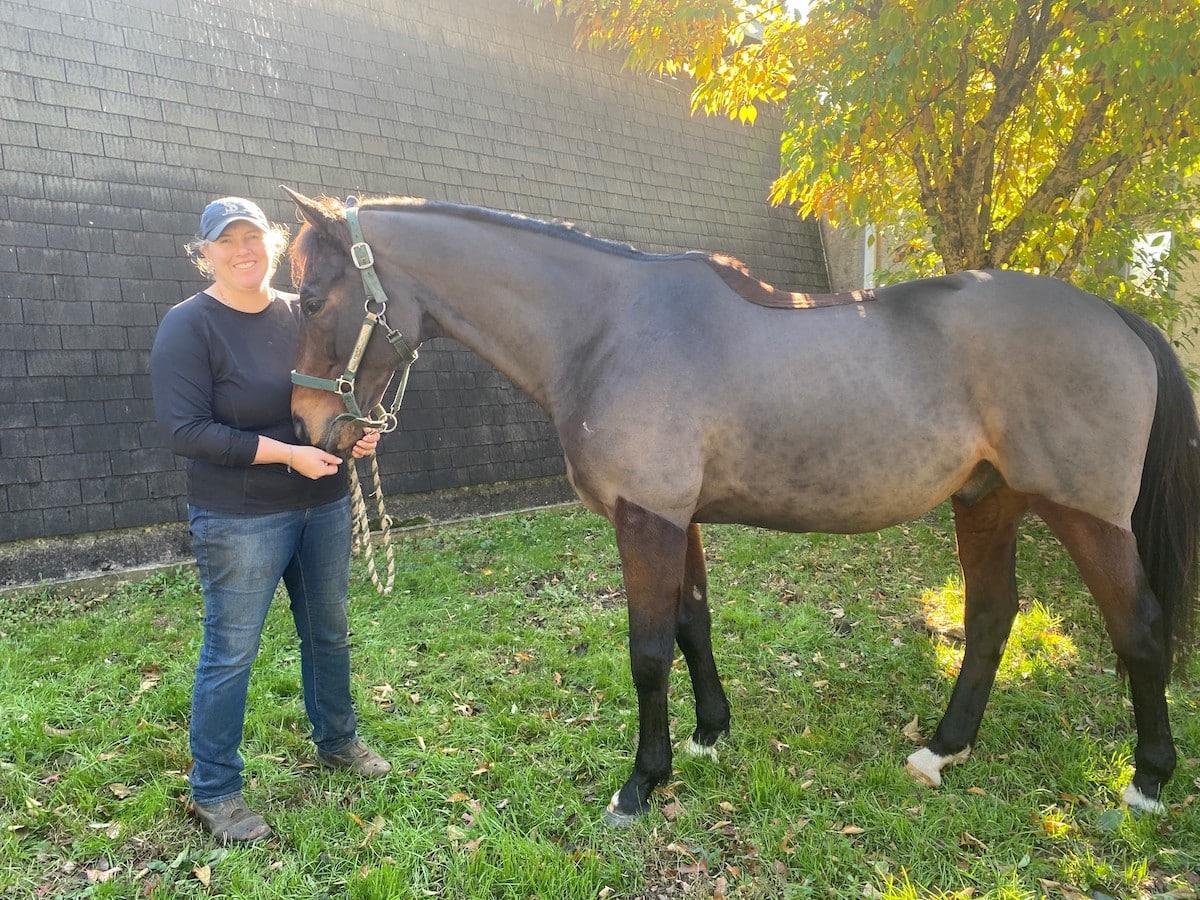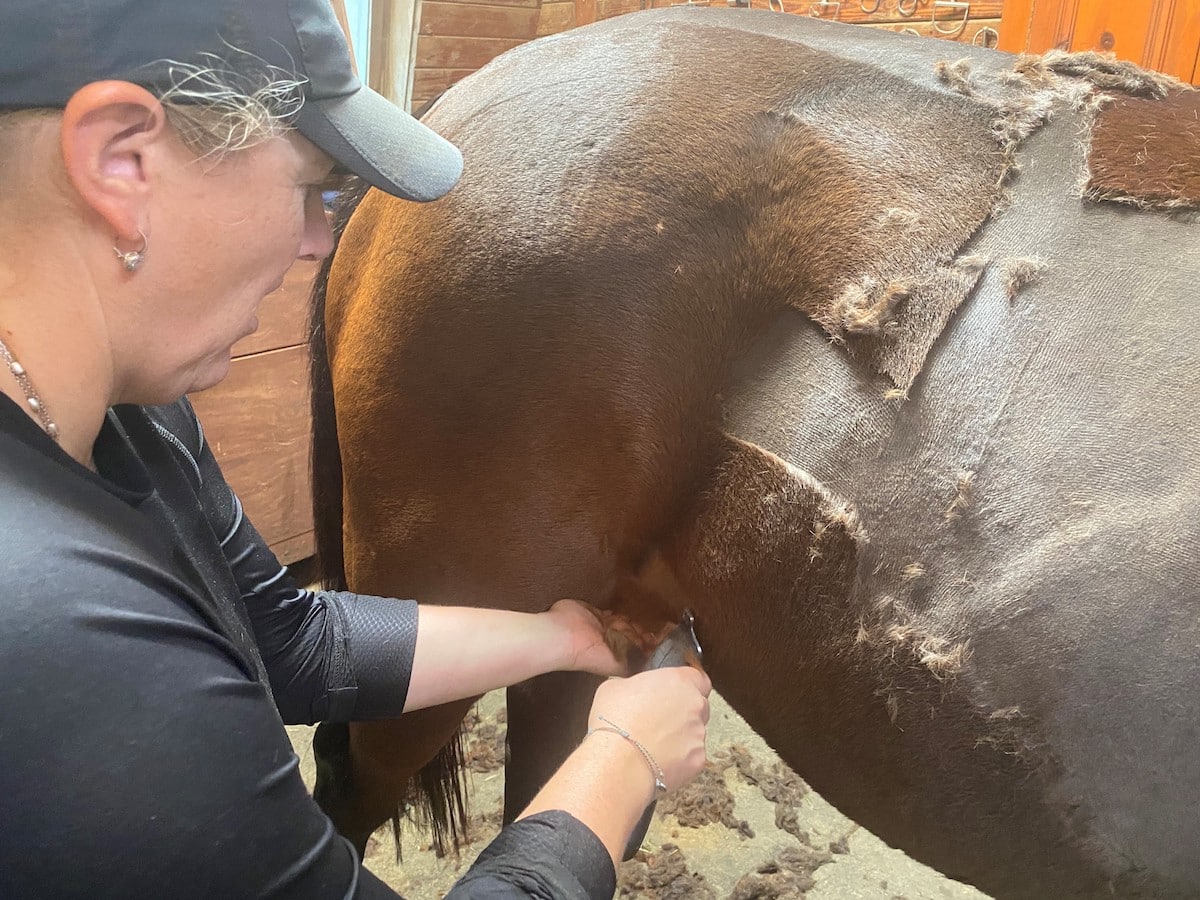Shave time off your cooldown and keep your horse comfortable during winter exercise with advice from professional groom Emma Ford

Emma Ford is the barn manager at Phillip Dutton’s True Prospect Farm, where she cares for horses such as 2014 America’s Most Wanted Thoroughbred Icabad Crane, seen here. Courtesy Emma Ford
Have you stood in the freezing cold with a cooler on your steaming, wet Thoroughbred, waiting for him to dry before putting him away for the night? Then it might be time to consider shaving time off your cooldown routine by clipping some or all of his coat.
To help you get started, we talked to Emma Ford, who’s the head groom and barn manager at Phillip Dutton Eventing/True Prospect Farm, in West Grove, Pennsylvania. She’s groomed for three Olympics and four World Equestrian Games, co-authored “World-Class Grooming for Horses: The English Rider’s Complete Guide to Daily Care and Competition” and teaches horse management clinics to horse people of all levels. In 2014 she groomed the RRP’s inaugural America’s Most Wanted Thoroughbred winner, Icabad Crane, who remains under her care and modeled for this article.
But Doesn’t My Horse Need His Winter Coat?
As the days shorten and we head toward winter, horses shed their slick summer coats and start putting on their winter woolies. It’s a rhythm as natural as the change of seasons and occurs in response to light exposure. That is, horses lose their winter coats as we move toward the summer solstice (the longest day of the year, around June 20 in the Northern Hemisphere) and build their winter coats as we get closer to the winter solstice (the shortest day of the year, around Dec. 20). This is true even for horses that live in warmer southern climates or cozy northern barns.
The equine winter coat is well-designed with insulative qualities that keep horses naturally warm and dry, provided they have access to shelter from wind and precipitation. However, this coat can make exercising horses, southern dwellers, senior horses and horses with poor thermoregulation or pituitary pars intermedia dysfunction (PPID, an endocrine disease that impedes shedding and causes excessive hair growth) hot and sweaty.
“Basically, the primary reason is for the comfort of the horse, whether you’re clipping them in the summer or the winter,” Ford says.
Once a horse is clipped, the owner or manager must commit to blanketing to make up for his missing hair. The more hair you take off the horse, the more blanketing he will require.
“You need to clip according to what you are able to do to take care of them, as well as what’s right for the horse,” Ford says. “If you are someone who doesn’t want to clip, you have to either not do the work that will make the horse hot and sweaty or you have the time to cool them off properly.”
Getting the Job Done Right
Like taking your dog to a groomer, you might have the opportunity to hire a professional to clip your horse. Or, you might want to invest in a quality pair of clippers and try clipping him yourself, which takes patience and practice but is doable, says Ford, who offers the following advice for perfecting your clipping technique:
1. Expose your horse to clippers first. Training goes a long way toward getting your horse ready to be clipped. Run the clippers so he gets used to the sound, then put them against his body without cutting the hair so he can feel the vibration, says Ford. “This is a really big thing with Thoroughbreds or any thin-skinned, sensitive horse,” she adds.
2. If the horse is new to clipping, have a helper hold him. To prevent accidents from a horse reacting to the clippers, only crosstie ones that have been clipped in the past and are reliably calm for the process, Ford says.
3. Offer your horse support if he’s nervous about or new to clipping. Ford recommends having a confident buddy horse near the horse you’re clipping if he’s nervous, young or hasn’t been clipped (though most horses coming off the track have, she adds). Letting him eat from a haynet while you clip can also help keep him still and distracted, she says.
4. Don’t rush. “Give yourself plenty of time,” Ford says. “It’s not something you want to be in a rush about. If you’re doing it for the first time, pick a Sunday that’s not busy in the barn and, if you need to, stop and give your horse a break.” A full body clip could take up to three hours, she says.
5. Be prepared to get hairy. Hair tends to go everywhere when you clip a horse and is itchy. Ford saves the task for the end of the day, so she can go home and shower as soon as she’s done. She also recommends wearing slick rain pants and a jacket so the hair doesn’t stick to your clothes.
6. Gather your tools and supplies. “Be organized, and make sure you have everything you need close by before you get started, including oil and coolant,” Ford says. A clipper lubricant keeps the blades running smoothly, and a coolant dissipates heat created by blade friction.
7. Start with a clean horse. Dirt dulls blades, causes the motor to work harder and overheat and can create uneven cutting that leaves lines on your horse’s coat. “Bathing the horse prior to clipping is probably the biggest tip I can give you,” Ford says. If you don’t have running hot water in the barn, you can curry and hot towel your horse to remove dirt and dust. She mixes Shapley’s No. 1 Light Oil with warm water prior to toweling. “It picks up the dirt and puts some oil into the coat to help the blades run more smoothly through the hair,” she says. “Or I will curry them really well with witch hazel.”
8. Novices: Use chalk to plan your clip. Experts like Ford can easily freehand their clips. However, if you’re new to the task and concerned about creating an even clip with straight lines, use chalk to outline a template on your horse.
9. Begin on the shoulder. Large, muscled body parts are easier to clip than bony areas and are good places to get your horse accustomed to the clippers before you work on more sensitive spots. “I always recommend starting on the shoulder,” she says. “You don’t want to start on the quarters and have them kick you,” she says.
10. Clip against the hair. For the tightest, smoothest and best clip, “always go against the hair,” Ford says.
11. Check the blade temperature and lubricate often. Again, the motor and friction cause clippers and their blades to heat up while in use. And they can get really hot. “As you’re clipping, check the blade temperature,” Ford says. “If you have a quieter horse who gets a bit wiggly, he might be saying, ‘Hey, those are hot.’ So always listen to your horse.” Lubricant and a coolant can help.
12. Use quality clippers, make sure your blades are sharp and have a spare pair on hand. Ford prefers Andis Pulse ZR II cordless clippers, which she says are quiet, have a three-hour battery life and allow for interchangeable blades. She uses a blade that creates a 3/16-inch cut for a working clip and one with a 1/16-inch cut for a shorter show clip. “I recommend having two sets of whatever size blade you use so you can switch them out if they get hot,” she says. If blades start leaving tracks or stop cutting, it’s time to have them sharpened or replaced.
13. Use a sedative if necessary. Some reactive or nervous horses might require sedation, especially for their first clips. “At the end of the day, it’s safer for me and the horse,” Ford says. Talk to your vet about options such as Dormosedan oral gel.
14. Avoid clipping once the horse has started shedding his winter coat. Clipping a horse after he’s started shedding risks trimming the tips off his incoming coat, which can dull it or change the color. However, Ford does clip a horse’s summer coat if she feels he needs shorter hair for his level of exercise and the weather.

Thoroughbreds can have sensitive skin at the bottom of the flank and stifle. Ford uses her free hand to stretch the skin and desensitize the area before applying light pressure to clip the hair. Courtesy Emma Ford
Take-Home Message
Clipping a horse’s coat might be necessary if you plan to ride during the winter or he gets overheated. The type of clip you choose depends on your climate and ability to keep him blanketed, as well as the horse’s turnout schedule and exercise level.
Types of Clips
You can choose from several types of clips. Ford says the right one for your horse depends on his exercise level and how much he sweats. Your climate and horse housing situation, as well as how committed you are to monitoring and blanketing your horse, are also important factors. The more hair you take off, the more management your horse will require to keep him comfortable as ambient temperatures fluctuate and weather changes. The following common clips are listed from most conservative (least hair removed) to most extreme (most hair removed).
Light work and mild climates
■ A chest or bib clip removes hair from the lower neck (optional if your horse doesn’t wear a neck cover) and chest and between the forelegs. You can also take the hair off the shoulder. This clip is best for horses in light work that spend most of their time outside. It also allows the horse to remain unblanketed on mild days.
■ A strip clip runs under the neck, down the chest and under the belly. This clip is best for horses in light work.
Light work and cold climates
■ A trace clip runs in a wide strip from the haunches, across the sides (including the belly) and up the neck.
■ A chaser clip is similar to a trace clip but also takes hair from the face.
■ A blanket clip runs in a strip along the haunches and across the barrel, leaving the area under the saddle unclipped, as well as the haunches where a quarter sheet would lie, the legs and possibly the head.
■ An Irish clip takes hair from the neck and shoulders and runs diagonally across the barrel, ending at the flank.
Heavy work or temperate/warm climates
■ A hunter clip removes all the coat, except on the legs, beneath the saddle and possibly the head.
■ A full body clip removes hair from the horse’s entire body, including his face and legs. Ford says she uses this clip for horses actively competing or moving south to warmer climates during the winter.
This article was originally published in the Winter 2021 issue of Off-Track Thoroughbred Magazine, the only publication dedicated to the Thoroughbred ex-racehorse in second careers. Want four information-packed issues a year delivered to your door or your favorite digital device? Subscribe now!

